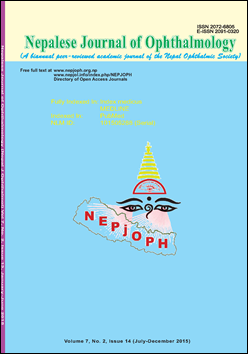Cycloplegic influence on the accuracy of autorefractometer in myopic and hyperopic children
DOI:
https://doi.org/10.3126/nepjoph.v7i2.14965Keywords:
Cycloplegia, autorefractometer, myopia, hyperopia, childrenAbstract
Objective: To investigate the cycloplegic effect on the accuracy of TOPCON AR RM-8000B autorefractometer in children.
Materials and methods: This study included 219 children of age 3 to 16 years. Topical 1% cyclopentolate hydrochloride was instilled for attaining cycloplegia. The children with the refractive error of –0.75 Diopter or more were grouped as myopic and more than +1.00 Diopter as hyperopic. Autorefraction was performed in addition to manual refraction. We used the XLSTAT and Medcalc statistics software.
Results: Out of 219 children, 149 (68%) were emmetropic, 48 (22%) hyperopic and 22 (10%) myopic (n=70). Males and females constituted 29 (60.42%) and 19 (39.58%) respectively in hyperopic group where as 11 (54.55%) and 9 (45.45%) children were myopic. The means of ages of the children were 10.29 (+/- 2.96) and 13.14 (+/- 2.36) years in hyperopic and myopic groups respectively. Cycloplegic hyperopic and myopic autorefraction revealed mean sphere of +1.45 and -4.06 diopter with correlation coefficient of 0.95 and 0.99 respectively. Non-cycloplegic hyperopic autorefraction showed 74.2% sensitivity and 8.3% specificity at >-1 diopter with area under curve of 0.517 (p<0.0001). Cycloplegic hyperopic autorefraction showed 100% sensitivity and 97.1% specificity at >+1.85 diopter with accuracy of 0.616. Non-cycloplegic myopic autorefraction showed 100% sensitivity and 0.91% specificity at >-0.75 diopter with accuracy of 0.889. Cycloplegic myopic autorefraction showed 100% sensitivity and specificity at >-1.25 diopter with perfect accuracy.
Conclusion: Non-cycloplegic hyperopic autorefraction failed to identify true negative cases. Cycloplegic autorefraction identified true positive cases and myopic autorefraction was relatively unaffected by cycloplegia.
Downloads
Downloads
Published
How to Cite
Issue
Section
License
This license enables reusers to copy and distribute the material in any medium or format in unadapted form only, for noncommercial purposes only, and only so long as attribution is given to the creator.




